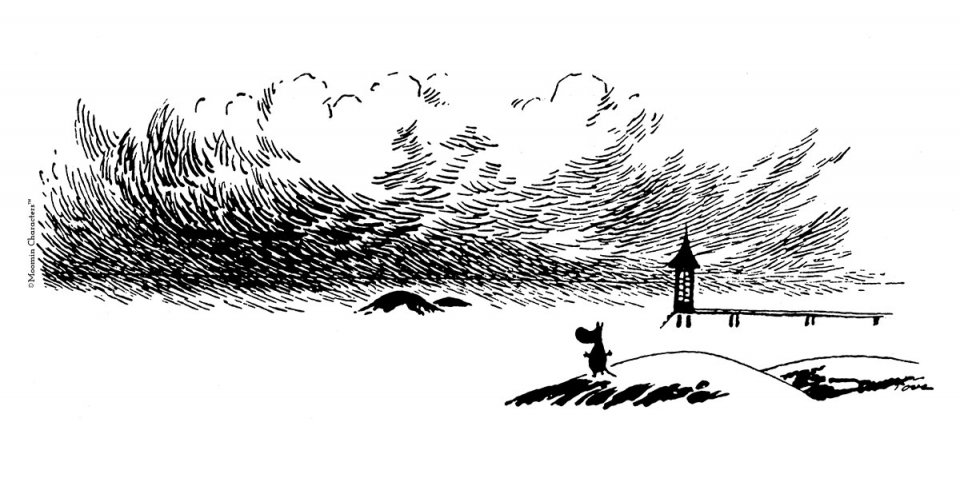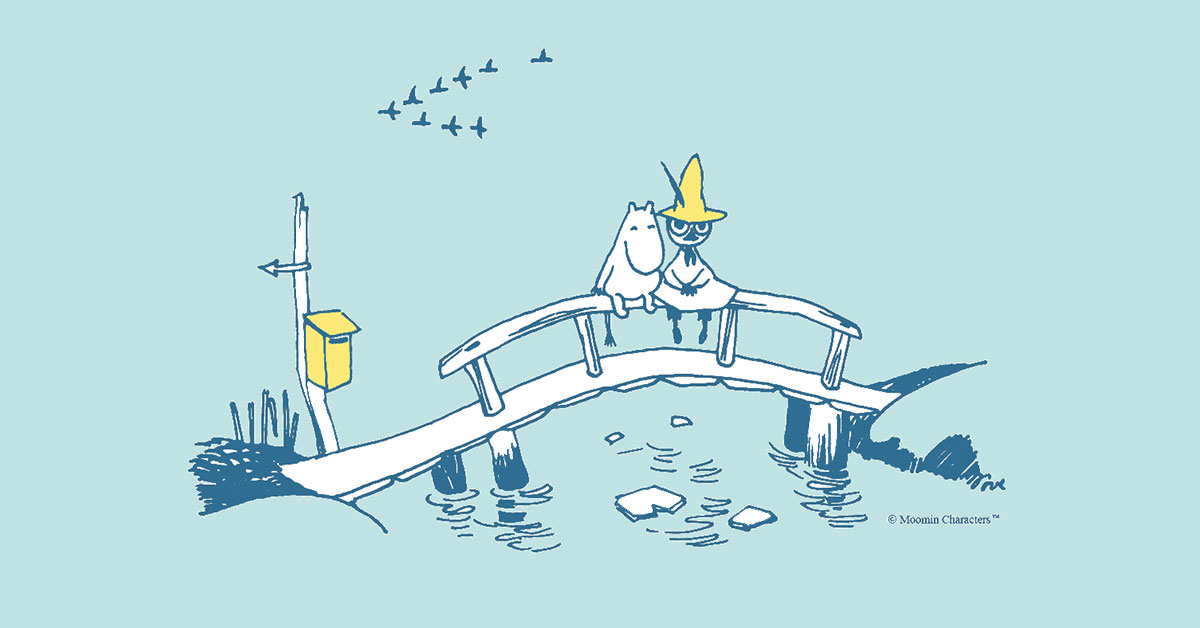Feathers from a swallow, shavings from a newly-tarred boat, eager anticipation – that’s the essence of spring by the sea as described by Tove Jansson both in her Moomin stories and other literature.
“The surest time is early spring, a protected space between city anxieties and full summer, which is green and contented and sociable. There are no boats moving among the islands. The sand is untouched, and the island has taken a small, furtive step toward wilderness since you last were here.
Its colors are cold and serious, fragile as the ice on the potholes. The sky is glass and utterly impassive. All is expectation, listening, with none of summer’s flirtatious charm.”
In the essay The Island, first published in the travel magazine “Turistliv i
Finland” 1961, republished in the collection Bulevarden och andra texter
The quote illustrates how Tove Jansson describes spring on an island. Both mind and art will be affected by the different seasons with their specific light phenomenons, temperatures and ambience. One moment you can plod along in the darkness over the frozen sea in thick snow – only to go for a moonlight swim at the exact same spot a month later, when seasons have changed to early summer. Tove Jansson has brilliantly described feelings as well as seasons in her prose.
Jansson’s long life by the sea forms a clear basis for her texts. She spent almost all her summers in Pellinki archipelago in the Gulf of Finland – and preferably moved out there early in the spring each year. For over 20 years she spent several months in the outermost archipelago at the island of Klovharu, with her life partner Tuulikki Pietilä. “The girls”, as the locals would call them, went out to the island in April and usually stayed until September.
“At night, the long-tailed ducks sing”
The essay The Island continues with a lyrical description of the warm feelings of happiness caused by the chilly spring nights.
“At night, the long-tailed ducks sing, always from an island farther out. You hear them when you get up to light a fire before dawn. Freezing, wildly happy, you stand at the door and see the barren land and rock in the half light.The plants that withered and died a year ago lie like a brown blanket over all the plants that have just decided to start growing.”
The Island, 1961
Long-tailed ducks are migratory birds that migrate to the Baltic Sea during the months of winter, in order to move further inland during summer.
Spring is birdtime in the archipelago. The arctic springtime migration pass the beaches of the Baltic sea when the sea birds stop over for a rest on their way north. When the archipelago birds start breeding a bit later in the spring, humans better watch out, as birds often aggressively protect their nests on islands like Klovharu.
The sea awakes with the sun
It’s not only the birds who become more active in the spring. Also beneath the surface of the sea it will start bubbling with life.
When sunlight starts to penetrate the shrinking layers of frozen ice all the way into the surface water, phytoplankton begin its springtime blooming. Once the ice has melted, small algies make the color of the sea greener. Simultaneously, perennial algies like bladderwrack awaken and start growing again. When the sea becomes warmer, fish like carp bream, roach and Northern pike start lekking in hidden bays. On the other hand, lekking of Baltic herring takes place in the protection of bladderwrack.
By the way, did you know that bladderwrack is a sign that the sea is in good condition? Tove Jansson drew bladderwrack in numerous sea pictures. Here’s an example from Comet in Moominland, describing the Moomintroll’s first encounter with the sea.
“‘Pooh!’ said Moomintroll diving into a big wave and swimming down through green bubbles of light. He went deeper and came upon forests of crinkly seaweed swaying gently in the current – seaweed that was decorated with beautiful white and pink shells – and even farther down the green twilight deepened until he could see only a black hole that seemed to have no bottom. Moomintroll turned round and shot up to the surface where a big wave carried him right back to the beach.”
Excitement of spring in Moominvalley
Also in Moominvalley spring has its given place. In the comic strip Spring in Moominvalley, written and illustrated by Tove Janssons’ brother Lars Jansson, there are different opinions as to what should be done during the first days of spring.
To meticulous Fillyjonk, spring cleaning is the natural first choice, whilst Moominmamma would prefer to sleep in the spring sun.
“Crocuses, shavings from a newly-tarred boat, feathers from a swallow, the last icicle. That’s the essence of spring”, Moominmamma explains to Fillyjonk, in order to help her understand spring.

Spring comes with promises of new adventures
Tove describes the excitement of spring also in her Moomin books.
“It certainly promised to be a fine day. Everywhere befuddled little creatures just woken from their long winter sleep poked about rediscovering old haunts, and busied themselves airing clothes, brushing out their moustaches and getting their houses ready for the spring. “
Finn Family Moomintroll, 1948
Spring and early summer in Moominvalley is a time of promises of new adventures, when there’s so much anticipation in the air that you hardly can sleep…
“And that night he couldn’t sleep, but lay looking out at the light June night which was full of lonely whisperings and rustlings and the pattering of feet. The air was sweet with the smell of flowers.
Snufkin wasn’t in yet. On such nights he often wandered about alone with his mouth-organ, but tonight there was no song to be heard. He was probably on a voyage of discovery, and soon he would put up his tent by the river, refusing to sleep indoors.”
Finn Family Moomintroll, 1948
Wonderful anticipation
The feelings Moomintroll and Snufkin experience during spring are familiar to most people who live by the Baltic Sea. Many Northerners long for light nights and warm days so eagerly, that we hardly notice the beauty of winter and spring. However, as Tove Jansson describes in her essay about early spring on an island, what if it’s all about anticipation after all?
“The water is still ice cold, the ground hard, and the light grows stronger every day. You know that warmth and paradise are there within reach. And every year you forget that happiness is in anticipation, not fulfillment.”
The Island, 1961
— —
This article is a part of the series Four seasons by Tove’s sea. During our campaign #OURSEA, we followed what happens in the Baltic Sea. It’s by these beaches that Tove Janson lived during four seasons. We also plinged on Tove’s descriptions of the seasons by the sea. Stay tuned for the following article, where we’ll plunge into the summer sea!
The #OURSEA campaign reached its goal of 1 million euros – a huge thank you to everyone who has participated in the campaign! As a warm thank you, on April 14, 2021, at 18:00 Finnish time (EEST) we livestreamed the beautiful “Haru, Island of the Solitary” documentary, which shows rarely seen footage of Tove Jansson’s summers on the Baltic Sea.

Winter through Moomintroll’s eyes: Quotes from Moominland Midwinter
Tove Jansson describes the cold season as beautifully as always, when depicting nature. Here are winter quotes from Moominland Midwinter.

A love letter to the sea – 7 Moomin quotes that make you feel you’re at sea
The Moomin stories are full of love and respect for the sea. Which one of these quotes makes you feel the scent of the sea in your nose?

An exclusive video reportage from Tove Jansson’s summer paradise
Tove Jansson’s Klovharun is an islet in the outermost archipelago of the Gulf of Finland, where Tove spent almost 30 summers.


